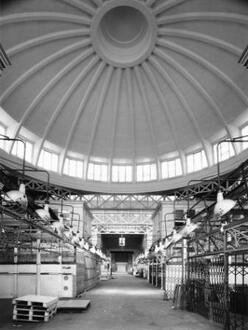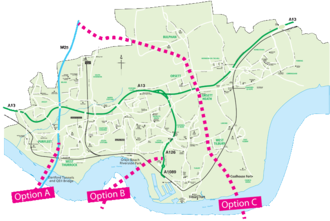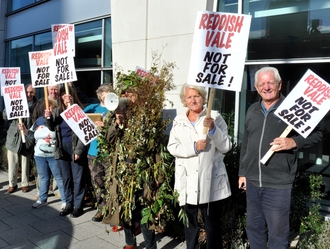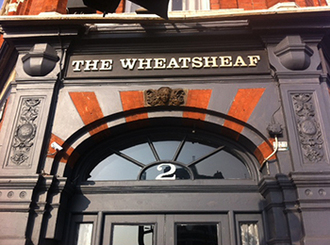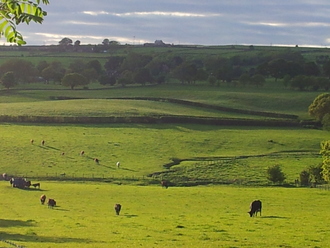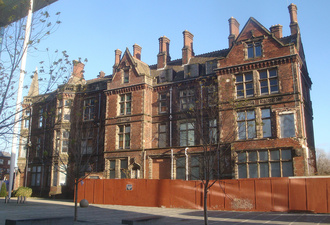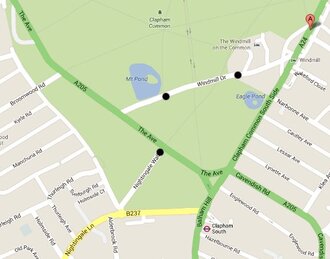-
SAVE Smithfield General Market!Smithfield General Market is under threat. A major London landmark, the buildings are part of one of the greatest market parades in Europe built by Sir Horace Jones, the architect of Tower Bridge. Proposals from a group of investors and developers have been approved by the City of London Corporation. These involve major demolition of the buildings only leaving 3 stretches of street frontages standing. The plans will see the interiors, including the great market halls, completely demolished to make way for offices that will rise up above the remaining facades. There are already too many empty office buildings in London - there is no need to build more. Moreover, the City has hundreds of thousands of square metres already in the pipeline not far from Smithfield. These proposals will cause substantial harm to the conservation area and will break up a complete group of protected historic market buildings. These buildings have been standing empty for too long. We are backing a fully-funded, viable, conservation-led alternative that would preserve the General Market and Fish Market in their entirety and allow them to open within months as a food market and a place for cafes, retail, bars and restaurants. The City of London Corporation was advised to put the site on the open market following a public inquiry five years ago, to allow a conservation-led scheme to come forward. The City, who own the freehold, never did this. We are asking the Secretary of State and his Planning Minister to call the application in for a full public inquiry, to ensure that this important site is saved for the nation. The campaign already has the support of all the National Amenity Societies, many local businesses and residents, and notable names such as Michelin-starred chef Fergus Henderson, author and playwright Alan Bennett, and MP Glenda Jackson. “If you go to St Bartholomew’s and then walk through Smithfield, it is like walking from one cathedral to another. You wouldn’t pull down St Bartholomew’s, nor should you pull down Smithfield. Smithfield was the scene of many martyrdoms – this would be another.” Alan Bennett “You can’t stop change but you should be able to recognize when something is extraordinary which Smithfield General Market is! This is the time to say no.” Fergus Henderson For more information please see SAVE's website: http://www.savebritainsheritage.org/news/campaigns.php Link to the most recent press article, in the Financial Times, August 2nd. ‘Smithfield: Alternative option for Reviving historic London Market.’ http://www.ft.com/cms/s/2/1510ebfa-f83f-11e2-b4c4-00144feabdc0.html#axzz2bBXyYs6d5,563 of 6,000 SignaturesCreated by Clementine Cecil
-
STOP THE NEW LOWER THAMES CROSSING INTO ESSEXThurrock is the most polluted area in the whole of UK but the Government have put forward proposals for a third Thames crossing between Essex and Kent which could make local people's lives a misery. Option C for the crossing would devastate over 100 acres of Green Belt as well as destroying a Fen, villages and a wildlife Hospital. Thousands of people will be given no choice but to sell their homes to the government and relocate. There is very little pristine land left in this part of the country. The new Thames crossing is being proposed on the grounds of reducing delays and congestion. Yet evidence from the Campaign for the Protection of Rural England shows that new routes actually increase congestion and road usage rather than reduce it. And with toll gates due to be removed on the existing crossing and bridge from 2014 the problem could be eased without the need to build another. Kent and Essex councils have already backed route C and whilst the department for transport says that it is considering all options there are indications that the decision has already made. Not only this, but at £5 billion Option C is more than double the cost of other routes at a time when budgets are stretched. Please sign the petition and help us stop these plans.12,840 of 15,000 SignaturesCreated by Veronica Prince
-
Keep the cycle lanes in Wandsworth Common and Tooting Bec CommonEven the analysis used by the Council to justify the change suggests that cycling speeds will only be reduced by 1 or 2 mph. In the space of a couple of hours, over 120 users of Wandsworth Common signed a petition to oppose the change. The Council chose to ignore them, to ignore their own policy, to ignore the needs of disabled people and ignore common sense. The Council used money from Transport for London to put the lines in. They now plan to use more money from TfL to take them out! Doing nothing would be infinitely preferable to this crazy scheme. By spending a fraction of £85,000 on simply improving the existing lanes and signage, the safety of all users could be improved. (NB funding amount was originally stated in this petition to be £82K).545 of 600 SignaturesCreated by Simon Shields
-
Save The Vale 2013It is Public Open Space and, by law, the proposed sell-off should have been the first proposal to be publicised. Even the councillors were not told until all the following decisions were made.The area in question is recognised on the council's own documentation in 2002 as "A Site of Importance to Nature" also as "the least disturbed woodland in the entire Country Park" The Country Park Boundary (set by Stockport MBC) was conceived and made public to make sure that the urban sprawl did not ruin the Country Park and to conserve wildlife and places of importance to Nature. If such concepts are obsolete in less than eleven years , what hope is there for our children?5,822 of 6,000 SignaturesCreated by Pat Ruaune

-
Save the Wheatsheaf - Tooting BecSince the Wheatsheaf has been refurbished the pub has become a real magnet for local people, showing that in the right hands it is very much a viable business. On Friday 19th July rumours were circulating that the lease had expired and the present tenant Gregarious (formerly Antic) were on 24hr closure notice. There was also concern that whilst Gregarious want to buy the lease they were being outbid by Tesco. On Saturday 20th July this petition was launched. Some 10 days later, over 8,000 people had signed the petition. Early wins - but there is still work to do: Sadiq Khan MP received a letter from Enterprise Inns (the owner of the freehold) on Tuesday 30th in the afternoon stating that they are no longer selling the pub. Tesco have also, via our MP, confirmed that they are no longer looking to purchase the pub. There are a few on-going actions to ensure that we can secure the pub should Enterprise Inns change their minds. An application to get the pub listed as a community asset has been made, an application to get an article 4 listing has been made, and we are also looking to get the building listed as a 'Wandsworth Borough Council Buildings of Special Architectural or Historic Interest'. Tooting is fortunate to have a diverse range of shops, and a lot of independent traders. We need to show the council the amount of support that exists to keep this community asset. On the blog you can find out more about how you can help to make sure that we win this battle. Tweet: #SavetheWheatsheaf and link to the petition please.8,821 of 9,000 SignaturesCreated by Jon Irwin
-
Save Aireborough's green spacesThere are many potential sites for new houses around Leeds which could be developed to create affordable homes within short distances of the City Centre where most employment is found. By allowing development of green fields on the outskirts of Leeds, the Council are increasing the congestion on local routes and public transport, as well as destroying some of Aireborough's most beautiful resources and it's uniqueness of character.Say NO to thoughtless and ill-concieved solutions to demand for homes. Say YES to a more careful and considerate approach to housing which respects and enhances Aireborough as a beautiful place to live.537 of 600 SignaturesCreated by Andrew Steer
-
Respect the Listed Buildings system - SAVE the Grade II listed Edwardian Jessop Hospital buildingSAVE Britain's Heritage and The Victorian Society took this case to the High Court and then the Court of Appeal in order to prevent a dangerous precedent in the misinterpretation of the new National Planning Policy Framework (Paragraph 133). They established that the public benefit achieved by demolition per se, needs to be considered, not just the overall 'public benefit' of a scheme. We are quite certain that this particular question was not properly considered by Sheffield University or Sheffield Council. English Heritage guidance states that "Grade II buildings are of special interest warranting every effort to preserve them". So far there has been no sincere effort to consider the public benefits of including the Grade II listed building in a new engineering building scheme and the option to keep the building was dismissed in six paragraphs of the University's 'Heritage Statement', as it did not meet the University's 'brief'. Façade retention would have lost a mere 5% to 10% space, yet this option was considered too much of a compromise. The most eloquent letter of objection to the scheme was written by the planning officers involved in the application themselves. This letter and other documents referenced here can all be viewed from the campaign website (link to side of this page: www.jessophospital.org.uk). Months later, their views had not changed and three weeks before that planning meeting, the Council's own Head of Urban design and Conservation advised the first author of the planning report: "As you are all too aware my view (reflected by that of Conservation Advisory Group, the Design Panel and fellow officers) is that the proposals for Jessop east have both serious conservation implications and constitute poor design and should therefore be refused in accordance with the NPPF... I've done my best to think of some positives but have come up with very little." We now know that the draft City Development Plan, which had been adopted, contained a clause (unchallenged since 2010) which expressly forbade the University from harming the listed Jessop buildings or their settings, given the "economies of scale" offered to the University by the site. English Heritage had been involved in tightening up the wording of this clause. This clause was silently removed by Sheffield City Council. Some University representatives have spread misinformation about the building, denigrating its status as a worthless extension. Yet this is in marked contrast to an independent historical report, commissioned by Sheffield University in 2008, which leaves no doubt about the architectural and historical merits of the building, reflected in its listing. The Jessop Women's Hospital takes its name from a great Sheffield philanthropist. Yet it is the architect, John Webster, who designed both Victorian and Edwardian buildings, who is the unsung hero of this story. Webster devoted his life to charitable causes and his role was pivotal in the development of Sheffield hospitals, which had a strong influence on what was to become the National Health Service. At the time that Jessop founded the women's Hospital, Webster co-founded and was chair of committee of Sheffield Children's Hospital, another great institution, at first located across the road from Jessops on Brook Hill. When the Children's Hospital moved to Western Bank, it was Webster who designed the new building. The Jessop's Hospital for Women is how both of these figures will be remembered. The two buildings, side by side, designed by the same notable architect 25 years apart and in different eras are a treasure which should be cherished and preserved together. They would long outlive the new building which is being proposed. Historic buildings have the power to connect us tangibly with our past. This building should be protected to enable our children to value and learn from a time when a sense of progress and Civic duty, not simple profit, was foremost in the minds of our nations' prime movers. This application began as an initiative to gain the University's Engineering facility every possible advantage. No one is against a New Engineering Building, but given all that has since come to light, we ask that the council of Sheffield University take the opportunity which is now available to urgently re-evaluate the demands of the original planning proposal. With the University now one year ahead of schedule, and English Heritage still to be offered an opportunity to record the building (a statutory requirement) this is a vital chance to seize the initiative and avoid untold and unnecessary damage.3,618 of 4,000 SignaturesCreated by Nicholas Roscoe
-
Better, safer, people-friendly streets for Clapham CommonThis will allow local residents an opportunity to experience their streets and the common in a different way and see if it delivers the proposed benefits. On the basis of experience elsewhere, the changed layout should: Stop through motor traffic on Nightingale Walk and Windmill Drive Make a more quiet and pleasant local environment. Make it safer for local residents, and users of the common. Reduce pot holes If towards the end of the trial local residents feel that it has not been an improvement then it will be easy to re-instate the current layout. Worth noting that this approach has already gone through the system for a network of streets in Tooting. By end August we should know when it will be implemented. This approach is also supported by the Wandsworth Cycling Campaign (part of London Cycling Campaign - http://www.lcc.org.uk), and Wandsworth Living Streets (local group of Living Streets - http://www.livingstreets.org.uk).352 of 400 SignaturesCreated by Jon Irwin
-
Stop Fracking in Cheshire West and ChesterHorizontal hydraulic fracturing, ‘fracking’, is a way of extracting oil and/or gas. Water, sand and toxic chemicals are injected at high pressure into underground rocks to shatter them. This releases the gas/oil which can be collected. But investing in carbon-intensive fossil fuels is a distraction from the need to decarbonise our electricity supply. And it's hazardous. Studies show that fracking pollutes water supplies (with arsenic and lead), causes earthquakes, and spoils local communities. And there are nightmare stories coming form the States. Like in the town of Dimock, PA, residents have reported their water turning so brown that it stains crockery. Their water was later found to contain methane, and a host of toxic chemicals. But it gets worse. "My son had sores up and down his legs from the water." " My daughter... would have to get out the of the shower and lay on the floor." Those are the words from Greg Saunter, a local resident, whose water supply was shut off for his own good. He cannot shower in his own home. Or drink water out of his taps. Fracking has ruined his life. It cannot happen here. We call on the council to preserve the quality of life of its residents, and reject all planning applications for fracking.435 of 500 SignaturesCreated by Zoe Cooper
-
Stop Fracking in St. HelensHorizontal hydraulic fracturing, ‘fracking’, is a way of extracting oil and/or gas. Water, sand and toxic chemicals are injected at high pressure into underground rocks to shatter them. This releases the gas/oil which can be collected. But investing in carbon-intensive fossil fuels is a distraction from the need to decarbonise our electricity supply. And it's hazardous. Studies show that fracking pollutes water supplies (with arsenic and lead), causes earthquakes, and spoils local communities. And there are nightmare stories coming form the States. Like in the town of Dimock, PA, residents have reported their water turning so brown that it stains crockery. Their water was later found to contain methane, and a host of toxic chemicals. But it gets worse. "My son had sores up and down his legs from the water." " My daughter... would have to get out the of the shower and lay on the floor." Those are the words from Greg Saunter, a local resident, whose water supply was shut off for his own good. He cannot shower in his own home. Or drink water out of his taps. Fracking has ruined his life. It cannot happen here. We call on the council to preserve the quality of life of its residents, and reject all planning applications for fracking.121 of 200 Signatures
-
Stop Fracking in LiverpoolHorizontal hydraulic fracturing, ‘fracking’, is a way of extracting oil and/or gas. Water, sand and toxic chemicals are injected at high pressure into underground rocks to shatter them. This releases the gas/oil which can be collected. But investing in carbon-intensive fossil fuels is a distraction from the need to decarbonise our electricity supply. And it's hazardous. Studies show that fracking pollutes water supplies (with arsenic and lead), causes earthquakes, and spoils local communities. And there are nightmare stories coming form the States. Like in the town of Dimock, PA, residents have reported their water turning so brown that it stains crockery. Their water was later found to contain methane, and a host of toxic chemicals. But it gets worse. "My son had sores up and down his legs from the water." " My daughter... would have to get out the of the shower and lay on the floor." Those are the words from Greg Saunter, a local resident, whose water supply was shut off for his own good. He cannot shower in his own home. Or drink water out of his taps. Fracking has ruined his life. It cannot happen here. We call on the council to preserve the quality of life of its residents, and reject all planning applications for fracking.102 of 200 Signatures
-
Stop Fracking in the WirralHorizontal hydraulic fracturing, ‘fracking’, is a way of extracting oil and/or gas. Water, sand and toxic chemicals are injected at high pressure into underground rocks to shatter them. This releases the gas/oil which can be collected. But investing in carbon-intensive fossil fuels is a distraction from the need to decarbonise our electricity supply. And it's hazardous. Studies show that fracking pollutes water supplies (with arsenic and lead), causes earthquakes, and spoils local communities. And there are nightmare stories coming form the States. Like in the town of Dimock, PA, residents have reported their water turning so brown that it stains crockery. Their water was later found to contain methane, and a host of toxic chemicals. But it gets worse. "My son had sores up and down his legs from the water." " My daughter... would have to get out the of the shower and lay on the floor." Those are the words from Greg Saunter, a local resident, whose water supply was shut off for his own good. He cannot shower in his own home. Or drink water out of his taps. Fracking has ruined his life. It cannot happen here. We call on the council to preserve the quality of life of its residents, and reject all planning applications for fracking.381 of 400 Signatures
Hello! We use cookies to improve your experience by providing insights into how the site is being used. Find out more.
